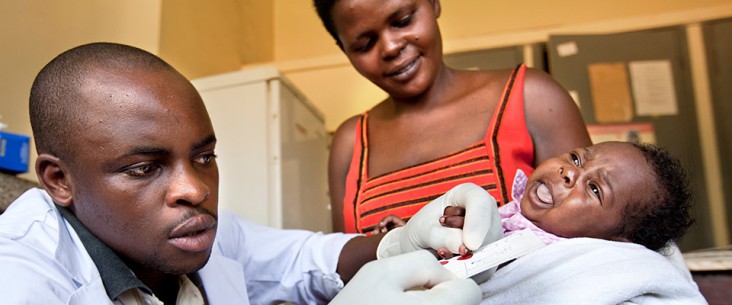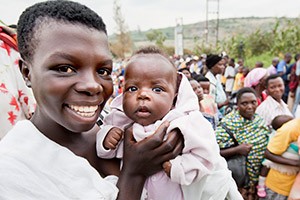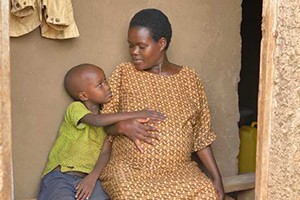- What We Do
- Agriculture and Food Security
- Democracy, Human Rights and Governance
- Economic Growth and Trade
- Education
- Ending Extreme Poverty
- Environment and Global Climate Change
- Gender Equality and Women's Empowerment
- Global Health
- Water and Sanitation
- Working in Crises and Conflict
- U.S. Global Development Lab

Background
According to recent estimates, HIV-positive pregnant women are eight times more likely to die during pregnancy, delivery or the postpartum period than HIV-negative pregnant women. In countries with generalized HIV and AIDS epidemics and HIV prevalence of 15 percent, it is estimated that up to half of all deaths during pregnancy and up to 12 months postpartum may be attributable to HIV and AIDS.
While reductions in maternal mortality have been made globally, it still remains one of the leading causes of death among women of reproductive age in developing countries, with more than half of all maternal deaths occurring in sub-Saharan Africa. This region is also most affected by the HIV epidemic and accounts for 69 percent of the global burden. In 2011, 92 percent of pregnant women living with HIV resided in sub-Saharan Africa. Thus, our greatest challenge in tackling two major killers of women – HIV and AIDS and maternal mortality – is in sub-Saharan Africa.
HIV-positive pregnant women are at increased risk of life-threatening infections such as sepsis and opportunistic infections, including TB; pneumonia; and meningitis. While the death of a mother is a tragedy in itself, it has devastating effects on the survival of her children, the economic stability of the family and the productivity of the community. The vast majority of maternal deaths are preventable when women have access to quality antenatal and postnatal care and safe delivery attended by skilled personnel that is backed by emergency obstetric care. Providing care and support for HIV-positive women during pregnancy and delivery and the postpartum period presents unique challenges not only for the prevention of HIV transmission from mother to child but also for the woman’s own health and survival.
USAID’s Response

The U.S. Agency for International Development (USAID) supports the U.S. President’s Emergency Plan for AIDS Relief (PEPFAR) goal of an AIDS-free generation by optimizing PEPFAR as a platform to incorporate and integrate other essential health services for women. USAID also has the goal of ending preventable child and maternal deaths by promoting high-impact interventions for pregnant and postpartum women while strengthening systems to provide quality maternity care. USAID pilots models of integrated service delivery by building on decades of our successes in improving maternal health and HIV prevention, care and treatment. We make a difference by focusing our work in developing countries with the most need – those that have high rates of both HIV and maternal mortality – with a particular focus on African countries.
USAID works in partnership with host country governments, the private sector, service providers and local stakeholders to integrate evidence-based maternal health and HIV and AIDS information and services to reach our goal of reducing maternal mortality and saving mothers’ lives.
Current Programmatic Highlights

African Strategies for Health (ASH)
ASH is a 5-year contract funded by the USAID Africa Bureau (USAID/AFR). Implemented by Management Sciences for Health (MSH), ASH works with a variety of African public sector, civil society and private sector health development institutions to guide investments that further the health of Africans. USAID/AFR; the Office of HIV/AIDS (OHA); and the Office of Health, Infectious Diseases and Nutrition (HIDN) worked with ASH to conduct a review and synthesis of operational issues around HIV and maternal health programs. The study identified (1) the demand side factors that influence women’s decisions to use and continue using antiretroviral drugs/antiretroviral therapy (ARVs/ART) during pregnancy, (2) the operational/service delivery factors affecting the use of ARVs/ART among pregnant women and (3) the most effective interventions to reduce maternal mortality among HIV-positive women.
Saving Mothers Giving Life (SMGL)
SMGL is a public-private partnership aimed at reducing maternal deaths by up to 50 percent in targeted districts. It is led by USAID, in collaboration with the Department of State, Centers for Disease Control and Prevention (CDC), Peace Corps, the Department of Defense, host country governments and private sector partners. The private sector partners include Project Cure, Merck for Mothers, the Government of Norway, Every Mother Counts and the American College of Obstetricians and Gynecologists. SMGL supports two USAID priorities: ending preventable child and maternal deaths and achieving an AIDS-free generation. SMGL utilizes a district-strengthening model that builds on the existing strong PEPFAR platform and makes strategic investments to reduce maternal deaths.
Maternal Health, HIV and AIDS: Examining Research through a Programmatic Lens
In June 2013, USAID partnered with the Maternal Health Task Force (MHTF) and the CDC to jointly convene a technical consultation called Maternal Health, HIV and AIDS: Examining Research through a Programmatic Lens. HIV and maternal health researchers from the United States, Europe and Africa converged to discuss emerging evidence linking maternal health and HIV, identify research gaps and consider programmatic implications. MHTF is the flagship program of the Women and Health Initiative at the Harvard School of Public Health and contributes to shaping collective efforts to improve the quality of maternal health care worldwide. It is funded by the Bill & Melinda Gates Foundation and other private donors.
Additional Resources
- Sub-Saharan Africa - AIDS epidemic facts and figures [PDF, 1.6MB]
- Report on the Global AIDS Epidemic [PDF, 1.1MB]
- 2012 UNAIDS World AIDS Day Report [PDF, 1.1MB]







Comment
Make a general inquiry or suggest an improvement.